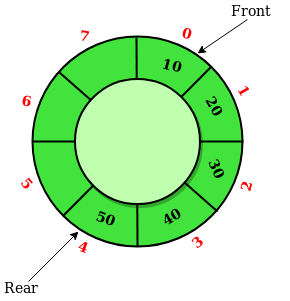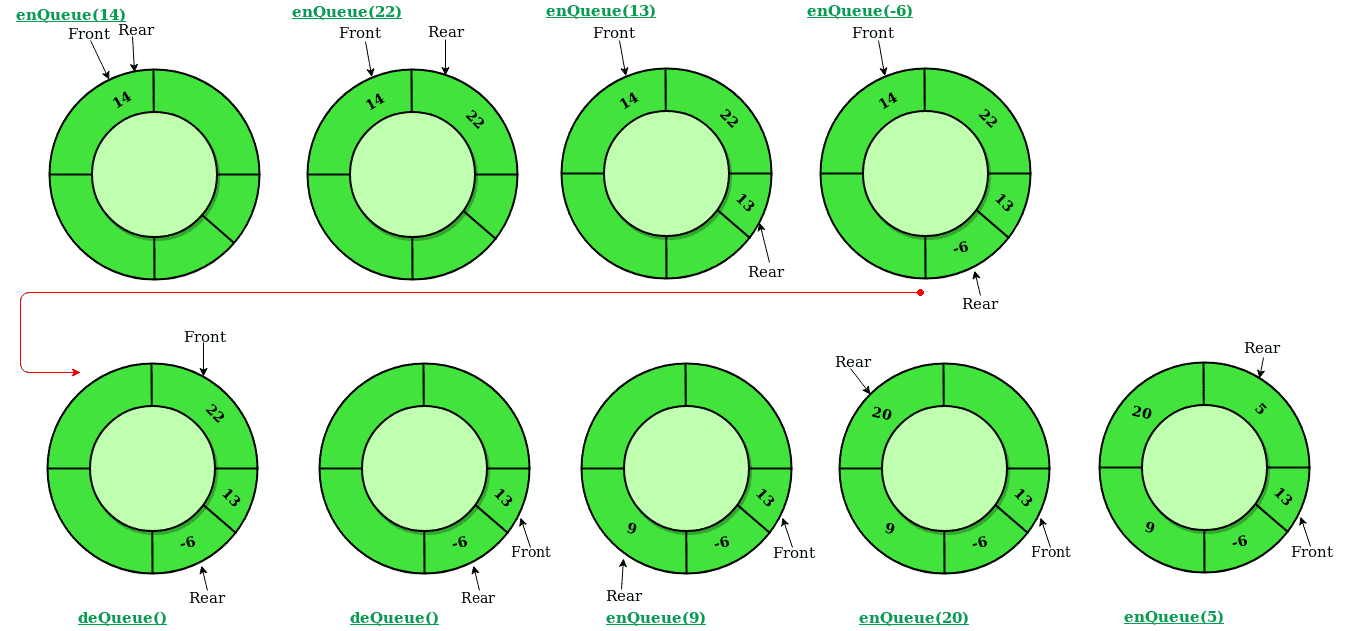先决条件—— 排队 循环队列是一种线性数据结构,其中的操作基于FIFO(先进先出)原理执行,最后一个位置连接回第一个位置以形成一个循环。它也被称为 “环形缓冲区” .
null

在普通队列中,我们可以插入元素,直到队列变满。但一旦队列已满,即使队列前面有空间,我们也无法插入下一个元素。

循环队列上的操作:
- 正面: 从队列中获取前面的项目。
- 后方: 从队列中获取最后一项。
- 排队(值) 此函数用于将元素插入循环队列。在循环队列中,新元素总是插在后面的位置。
- 检查队列是否已满–检查((后==SIZE-1和前==0)| |(后==front-1))。
- 如果已满,则显示队列已满。如果队列未满,则检查(后==大小–1&&前!=0)是否为真,然后设置后=0并插入元素。
- 出列 此函数用于从循环队列中删除元素。在循环队列中,元素总是从前面位置删除。
- 检查队列是否为空表示检查(前面==-1)。
- 如果为空,则显示队列为空。如果队列不为空,则执行步骤3
- 检查(front==rear)是否为真,然后设置front=rear=-1,否则检查(front==size-1),如果为真,则设置front=0并返回元素。
C++
// C or C++ program for insertion and // deletion in Circular Queue #include<bits/stdc++.h> using namespace std; class Queue { // Initialize front and rear int rear, front; // Circular Queue int size; int *arr; public : Queue( int s) { front = rear = -1; size = s; arr = new int [s]; } void enQueue( int value); int deQueue(); void displayQueue(); }; /* Function to create Circular queue */ void Queue::enQueue( int value) { if ((front == 0 && rear == size-1) || (rear == (front-1)%(size-1))) { printf ( "Queue is Full" ); return ; } else if (front == -1) /* Insert First Element */ { front = rear = 0; arr[rear] = value; } else if (rear == size-1 && front != 0) { rear = 0; arr[rear] = value; } else { rear++; arr[rear] = value; } } // Function to delete element from Circular Queue int Queue::deQueue() { if (front == -1) { printf ( "Queue is Empty" ); return INT_MIN; } int data = arr[front]; arr[front] = -1; if (front == rear) { front = -1; rear = -1; } else if (front == size-1) front = 0; else front++; return data; } // Function displaying the elements // of Circular Queue void Queue::displayQueue() { if (front == -1) { printf ( "Queue is Empty" ); return ; } printf ( "Elements in Circular Queue are: " ); if (rear >= front) { for ( int i = front; i <= rear; i++) printf ( "%d " ,arr[i]); } else { for ( int i = front; i < size; i++) printf ( "%d " , arr[i]); for ( int i = 0; i <= rear; i++) printf ( "%d " , arr[i]); } } /* Driver of the program */ int main() { Queue q(5); // Inserting elements in Circular Queue q.enQueue(14); q.enQueue(22); q.enQueue(13); q.enQueue(-6); // Display elements present in Circular Queue q.displayQueue(); // Deleting elements from Circular Queue printf ( "Deleted value = %d" , q.deQueue()); printf ( "Deleted value = %d" , q.deQueue()); q.displayQueue(); q.enQueue(9); q.enQueue(20); q.enQueue(5); q.displayQueue(); q.enQueue(20); return 0; } |
JAVA
// Java program for insertion and // deletion in Circular Queue import java.util.ArrayList; class CircularQueue{ // Declaring the class variables. private int size, front, rear; // Declaring array list of integer type. private ArrayList<Integer> queue = new ArrayList<Integer>(); // Constructor CircularQueue( int size) { this .size = size; this .front = this .rear = - 1 ; } // Method to insert a new element in the queue. public void enQueue( int data) { // Condition if queue is full. if ((front == 0 && rear == size - 1 ) || (rear == (front - 1 ) % (size - 1 ))) { System.out.print( "Queue is Full" ); } // condition for empty queue. else if (front == - 1 ) { front = 0 ; rear = 0 ; queue.add(rear, data); } else if (rear == size - 1 && front != 0 ) { rear = 0 ; queue.set(rear, data); } else { rear = (rear + 1 ); // Adding a new element if if (front <= rear) { queue.add(rear, data); } // Else updating old value else { queue.set(rear, data); } } } // Function to dequeue an element // form th queue. public int deQueue() { int temp; // Condition for empty queue. if (front == - 1 ) { System.out.print( "Queue is Empty" ); // Return -1 in case of empty queue return - 1 ; } temp = queue.get(front); // Condition for only one element if (front == rear) { front = - 1 ; rear = - 1 ; } else if (front == size - 1 ) { front = 0 ; } else { front = front + 1 ; } // Returns the dequeued element return temp; } // Method to display the elements of queue public void displayQueue() { // Condition for empty queue. if (front == - 1 ) { System.out.print( "Queue is Empty" ); return ; } // If rear has not crossed the max size // or queue rear is still greater then // front. System.out.print( "Elements in the " + "circular queue are: " ); if (rear >= front) { // Loop to print elements from // front to rear. for ( int i = front; i <= rear; i++) { System.out.print(queue.get(i)); System.out.print( " " ); } System.out.println(); } // If rear crossed the max index and // indexing has started in loop else { // Loop for printing elements from // front to max size or last index for ( int i = front; i < size; i++) { System.out.print(queue.get(i)); System.out.print( " " ); } // Loop for printing elements from // 0th index till rear position for ( int i = 0 ; i <= rear; i++) { System.out.print(queue.get(i)); System.out.print( " " ); } System.out.println(); } } // Driver code public static void main(String[] args) { // Initialising new object of // CircularQueue class. CircularQueue q = new CircularQueue( 5 ); q.enQueue( 14 ); q.enQueue( 22 ); q.enQueue( 13 ); q.enQueue(- 6 ); q.displayQueue(); int x = q.deQueue(); // Checking for empty queue. if (x != - 1 ) { System.out.print( "Deleted value = " ); System.out.println(x); } x = q.deQueue(); // Checking for empty queue. if (x != - 1 ) { System.out.print( "Deleted value = " ); System.out.println(x); } q.displayQueue(); q.enQueue( 9 ); q.enQueue( 20 ); q.enQueue( 5 ); q.displayQueue(); q.enQueue( 20 ); } } // This code is contributed by Amit Mangal. |
Python 3
class CircularQueue(): # constructor def __init__( self , size): # initializing the class self .size = size # initializing queue with none self .queue = [ None for i in range (size)] self .front = self .rear = - 1 def enqueue( self , data): # condition if queue is full if (( self .rear + 1 ) % self .size = = self .front): print ( " Queue is Full" ) # condition for empty queue elif ( self .front = = - 1 ): self .front = 0 self .rear = 0 self .queue[ self .rear] = data else : # next position of rear self .rear = ( self .rear + 1 ) % self .size self .queue[ self .rear] = data def dequeue( self ): if ( self .front = = - 1 ): # condition for empty queue print ( "Queue is Empty" ) # condition for only one element elif ( self .front = = self .rear): temp = self .queue[ self .front] self .front = - 1 self .rear = - 1 return temp else : temp = self .queue[ self .front] self .front = ( self .front + 1 ) % self .size return temp def display( self ): # condition for empty queue if ( self .front = = - 1 ): print ( "Queue is Empty" ) elif ( self .rear > = self .front): print ( "Elements in the circular queue are:" , end = " " ) for i in range ( self .front, self .rear + 1 ): print ( self .queue[i], end = " " ) print () else : print ( "Elements in Circular Queue are:" , end = " " ) for i in range ( self .front, self .size): print ( self .queue[i], end = " " ) for i in range ( 0 , self .rear + 1 ): print ( self .queue[i], end = " " ) print () if (( self .rear + 1 ) % self .size = = self .front): print ( "Queue is Full" ) # Driver Code ob = CircularQueue( 5 ) ob.enqueue( 14 ) ob.enqueue( 22 ) ob.enqueue( 13 ) ob.enqueue( - 6 ) ob.display() print ( "Deleted value = " , ob.dequeue()) print ( "Deleted value = " , ob.dequeue()) ob.display() ob.enqueue( 9 ) ob.enqueue( 20 ) ob.enqueue( 5 ) ob.display() # This code is contributed by AshwinGoel |
输出
Elements in Circular Queue are: 14 22 13 -6 Deleted value = 14Deleted value = 22Elements in Circular Queue are: 13 -6 Elements in Circular Queue are: 13 -6 9 20 5 Queue is Full
时间复杂性: enQueue()、deQueue()操作的时间复杂度为O(1),因为任何操作中都没有循环。 应用:
- 内存管理: 普通队列中未使用的内存位置可以在循环队列中使用。
- 交通系统: 在计算机控制的交通系统中,环形队列用于按照设定的时间逐个重复打开交通灯。
- CPU调度: 操作系统通常维护一个准备好执行或等待特定事件发生的进程队列。
本文由 阿卡什·古普塔 .如果你喜欢GeekSforgek,并想贡献自己的力量,你也可以使用 写极客。组织 或者把你的文章寄去评论-team@geeksforgeeks.org.看到你的文章出现在Geeksforgeks主页上,并帮助其他极客。如果您发现任何不正确的地方,或者您想分享有关上述主题的更多信息,请写下评论。
© 版权声明
文章版权归作者所有,未经允许请勿转载。
THE END


![关于”PostgreSQL错误:关系[表]不存在“问题的原因和解决方案-yiteyi-C++库](https://www.yiteyi.com/wp-content/themes/zibll/img/thumbnail.svg)



